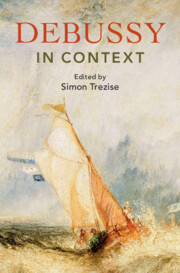Book contents
- Debussy in Context
- Composers in Context
- Debussy in Context
- Copyright page
- Dedication
- Contents
- Illustrations
- Contributors
- Preface
- Notes on the Text
- Abbreviations
- Part I Paris: City, Politics, and Society
- Part II The Arts
- Chapter 6 Debussy’s Impressionism Interrogated
- Chapter 7 Symbolism
- Chapter 8 Modernism
- Chapter 9 Wagnérisme
- Chapter 10 Japonisme, Collecting, and the Expositions Universelles
- Chapter 11 Cross-Currents in Debussy’s Creative World
- Part III People and Milieu
- Part IV Musical Life: Infrastructure and Earning a Living
- Part V The Music of Debussy’s Time
- Part VI Performers, Reception, and Posterity
- Recommendations for Further Reading and Research
- Index
Chapter 7 - Symbolism
from Part II - The Arts
Published online by Cambridge University Press: 23 May 2024
- Debussy in Context
- Composers in Context
- Debussy in Context
- Copyright page
- Dedication
- Contents
- Illustrations
- Contributors
- Preface
- Notes on the Text
- Abbreviations
- Part I Paris: City, Politics, and Society
- Part II The Arts
- Chapter 6 Debussy’s Impressionism Interrogated
- Chapter 7 Symbolism
- Chapter 8 Modernism
- Chapter 9 Wagnérisme
- Chapter 10 Japonisme, Collecting, and the Expositions Universelles
- Chapter 11 Cross-Currents in Debussy’s Creative World
- Part III People and Milieu
- Part IV Musical Life: Infrastructure and Earning a Living
- Part V The Music of Debussy’s Time
- Part VI Performers, Reception, and Posterity
- Recommendations for Further Reading and Research
- Index
Summary
Although Impressionism and Symbolism are but two of the numerous ‘-isms’ found in Paris in Debussy’s early years, these two movements are invariably associated with him. This chapter defines the symbolist literary style in France and surveys its development through some of its leading figures as well as its diffusion through some of its main institutions (Mallarmé’s salon, cafés, journals, bookstores). The author distinguishes between two phases in Debussy’s creative output: 1882–1902, when French-speaking literary symbolism clearly dominated the composer’s inspiration, and 1902–1917, when he became receptive to a wider range of poetry (especially that of French poets from the 15th to the 17th centuries). Important Debussy landmark pieces inspired by Symbolist writers (mélodies, the orchestral piece Prélude à l’après-midi d’un faune, and the opera Pelléas et Mélisande) are situated within the context of other musical works equally inspired by the same writers (Fauré, Bonheur, Bréville, Chabrier, Charpentier, Chausson, Duparc, Ravel).
- Type
- Chapter
- Information
- Debussy in Context , pp. 69 - 78Publisher: Cambridge University PressPrint publication year: 2024

